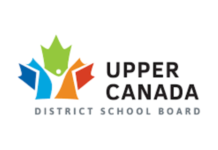The Provincial Government announced its plan to modernize classrooms and learning for students across the province. Some of the key elements of that announcement were: a provincial focus on e-learning, new standards for cellphone use in classrooms, increased class sizes at the secondary level, new curriculum for math, further guidelines for the health and physical education curriculum, changes to hiring practices, and additional funding support for student transportation.
“The provincial government’s announcement about a new vision for education in Ontario has certainly caught our attention. Our first impression is that there will be many changes forthcoming for our schools,” says John McAllister, Chair of the Upper Canada District School Board (UCDSB). “We respect that the government wishes to place its imprint on the K to 12 program and we look forward to learning what it will mean for us to implement this vision at the local level – especially given our Board’s mission to ‘prepare all students for a successful life.’”
E-Learning: Starting in 2020-21, the provincial government will centralize the delivery of all e-learning courses to allow students greater access to programming and educational opportunities, no matter where they live in Ontario. Students will be required to take at least four e-learning courses to achieve their Ontario Secondary School Diploma. This is a change that the UCDSB feels will significantly benefit its students and families, as the district has seen overwhelming success and growth in its web-based programs. From 2017 to 2018 there was a 63% increase in online course enrolment offered during the UCDSB Summer Semester, which is an online offering of diploma credits. During the regular school year, the popularity of e-learning among students has resulted in more than 1180 online credits already earned this school year, up from 990 last year.
“It is the Board’s concern that students be supported in UCDSB secondary schools as they pursue e-learning courses,” says McAllister. “The UCDSB has a number of strategies that may dove-tail well with the government’s goal.” The UCDSB has found that e-learning courses give students the opportunity to customize their programs to meet their interests and needs, even when enrolment challenges in a small school setting have prevented the ability to offer certain courses.
Student Transportation: The UCDSB is also very pleased to learn that there will be additional funding support for school boards to address financial pressures related to student transportation services. This funding will be available to school boards that operate efficient transportation services but run into unforeseen costs that exceed their allocated budget. “We find this acknowledgement and commitment of additional support encouraging, given how our school board is facing unusual financial pressures related to the current cost of student transportation due to a recent arbitration decision,” says McAllister. “We welcome further details from the Ministry of Education so we can move beyond our current challenges in providing this important service to students.”
Cellphones in Classrooms: The UCDSB already has a strong alignment with the new standards that the government will put in place for the 2019-2020 school year. The new standards indicate that the use of cellphones during instructional time will be permitted only under the following circumstances: for educational purposes, as directed by the educator; for health and medical purposes; and to support students with special education needs.
While there is a need to ensure continuity between schools, the government’s announcement provides an opportunity for school administration and the school board itself to review its practices and commitments in this area.
The current use of cell phones in UCDSB classrooms conforms with three existing policies that support the use of technology in the classroom. It is important to note that digital etiquette and directed learning by the teacher are the primary objectives.
Curriculum, Class Sizes and Staffing: School boards are waiting for further clarification and implementation strategies regarding curriculum changes, secondary class sizes, and hiring practices.
“These are early days however, members of the Board and administration are reviewing the specifics of this announcement to better understand what it will mean for our students, staff, and our school district in general,” says Director of Education Stephen Sliwa. “We also know that the province has identified additional stakeholder consultations on some of the key factors tied to Friday’s announcement, such as class size and teacher hiring. Arising from these consultations, we can expect that the Ministry of Education will provide further clarification and direction to all school boards in the weeks ahead.”








